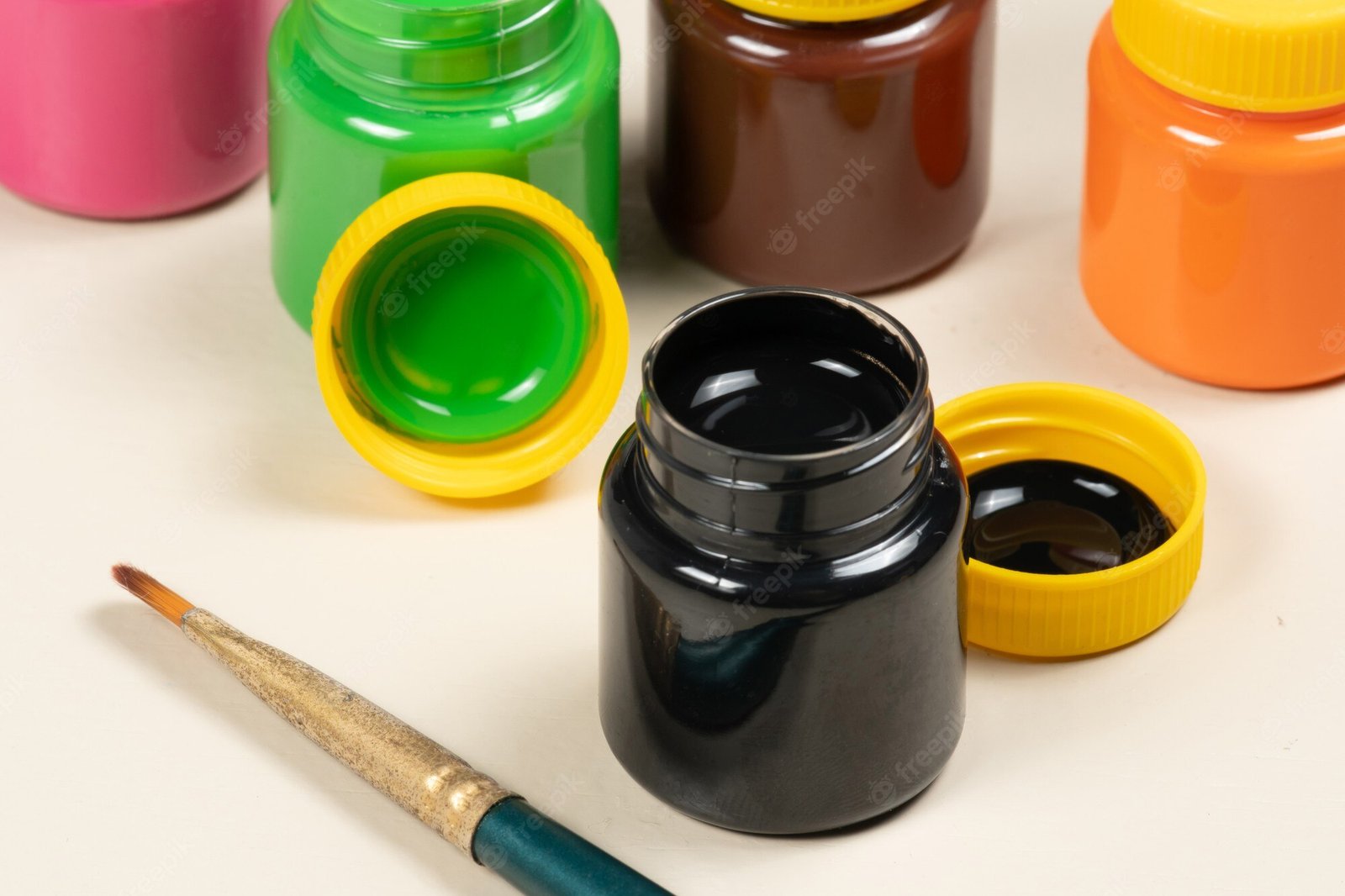Acrylic paint is a widely utilized medium for various art projects including crafting, painting, and DIY projects. However, there are often concerns about its ability to adhere to plastic surfaces. One of the concerns is if acrylic paint can stick to plastic?
Acrylic paint will stick to plastic, but it depends on the type of plastic and the surface preparation first. Some plastics, such as polyethylene and polypropylene, really a have a non-stick surface that can make it difficult for paint to adhere. In order to get the best adhesion, clean and lightly sand to create a rough surface for the paint to grip. Additionally, applying a plastic primer specifically designed for the type of plastic can help improve the adhesion of the acrylic paint.
Have you ever wanted to paint something plastic but wondered if the acrylic paint will stick?. In this blog post, I’ll show you how to stick acrylic paint to plastic.
Related Reading
- Can You use Acrylic Paint on Wood?
- Can You Use Acrylic Paint on Leather?
- Can You Use Acrylic Paint on Metal?
- Can You Use Acrylic Paint on Shoes?
- Can You Use Acrylic Paint on Skin?
Beginner’s Guide To painting Acrylic Paint on Plastic


Painting with acrylics on plastic can be a rewarding . While acrylic paint is often used on traditional surfaces like metal , skin Fabric, glass, wood, Leather and shoes, it can also be a fantastic medium for painting on plastic. Whether you want to give a new look to plastic toys, create custom decorations, or personalize everyday items, here’s how you can paint on plastic using acrylic paint
Step 1: Know the Type of Plastic You are Working With
Before diving into your project, identify the type of plastic you’re working with. Look for recycling symbols on the plastic item or consult the manufacturer’s information to determine its composition. Some plastics are more receptive to acrylic paint adhesion while others may require additional preparation steps such as priming or sanding.
Step 2 : Preparing the Surface
To ensure the best adhesion and longevity of your acrylic paint, prepare the plastic surface. You can start by cleaning the plastic object with soap and water to remove any dirt, dust, or oils. Next, lightly sand the surface using fine-grit sandpaper to create a rough texture that helps the paint adhere better. I recommend these 20pcs sand paper sheets from Maxman. Be careful not to over-sand or damage the plastic.
Step 3: Apply Primer
There are many different types of primer that can be used for acrylic paints. Choose one that can give you either matte or glossy finish . Also, make sure it dries clear fast and helps create a smooth surface, which is important when working with acrylics .You don’t want any brush strokes or rough patches on your project.
To apply primer;
- Simply brush it on your surface ;
- Let it dry completely before painting over it with your chosen colour.
Step 4: Paint The Plastic
Pour some acrylic paint into a plastic container. You can use any kind of plastic container, but I find that Tupperware works best. The reason being that it’s plastic. Use these acrylic paint brushes and start painting! They come as a 20pcs set to make your painting easier.
Step 5: Adding Details and Techniques
Once the base coat is dry, you can add details, patterns, or textures to your plastic object using various techniques. Experiment with different brush strokes, sponge dabbing, stencils, or even masking tape to create interesting effects. Acrylic paints dry quickly, allowing you to layer colors and work efficiently.
Step 6: Seal The Plastic
To protect your acrylic paint on plastic and enhance its longevity, consider applying a clear topcoat or varnish. This Mod Podge Version is specifically designed to adhere to plastic. You can also try any varnish that provides a protective layer against scratches and fading while adding a professional finish to your artwork.
Step 7 : Dry It
Now that your sealer is on there, let it dry thoroughly before continuing with your painting process. You can speed up this process by using an electric fan or hair dryer to help things along!
How to Seal Acrylic Paint on Plastic?
The most common sealer for acrylic paint on plastic is Mode Podge, but you can also use clear nail polish or spray lacquer to seal the paint.
- Step 1 – Clean the Surface
Before sealing the acrylic paint on your plastic item, you’ll need to clean it with rubbing alcohol or soap and water to remove any dirt or grease from the surface.
- Step 2 – Apply Sealer
Apply your chosen sealer in thin layers, allowing each layer to dry before applying another coat. If you’re using Mode Podge, apply one thick layer at a time, then let it dry completely before adding another layer of sealant.
How Do You Get Acrylic Paint to Stick To Plastic?
There are a few things you can try to make acrylic paint stick to plastic.
- Try adding a few drops of rubbing alcohol to the mixture, then shake it up and let it sit for a few minutes before painting. The alcohol will evaporate quickly and leave behind a thin layer of water that helps to lock the paint in place.
- You can also try using spray adhesive instead of water-based paints; spray adhesive dries clear, so there won’t be any white residue left behind after the paint dries (this is especially helpful if you’re using glitter).
What Kind of Paint Will Stick To Plastic?
Now that you know what it takes to paint on plastic, here are the certain types of paints that will adhere to plastic and won’t give you a hard time;
- Acrylic Paint: Acrylic paint is widely and commonly for plastic surfaces. It offers good adhesion, dries relatively quickly, and provides a durable finish. Here are the best acrylic paints in 2023, check them out !
- Spray Paint: Spray paint is another popular option for painting plastic. It provides even coverage and can easily reach intricate or hard-to-reach areas.
- Enamel Paint: Enamel paints are oil-based paints that provide excellent adhesion and durability on plastic surfaces. They offer a smooth, glossy finish and are often used for model kits, toys, and automotive applications. Enamel paints usually require a longer drying time and may emit strong fumes, so proper ventilation is essential when using them.
- Latex Paint: Latex paint can adhere to some plastic surfaces, but it may not be as durable as other options. It’s generally recommended to use latex paint on plastic surfaces that won’t undergo heavy use or frequent handling. Primer or surface preparation may be necessary to improve adhesion.
- Vinyl Dye: Vinyl dye is a specialized paint designed specifically for vinyl and plastic surfaces. It chemically bonds with the surface, creating a durable and long-lasting finish. Vinyl dye is often used for automotive interiors, upholstery, and vinyl surfaces.
Expert Advice: Do a proper surface preparation, such as cleaning, sanding, and priming first before applying any paint on plastic. You can always follow the instructions provided by the paint manufacturer for the best results.
Best Acrylic Paint for Plastic
1)K05644007 COLORmaxx Acrylic Latex paint


You should use Krylon® K05644007 COLORmaxx Acrylic Latex paint on your plastic project because it has excellent adhesion. This acrylic paint is specially formulated to adhere effectively to plastic surfaces, ensuring a strong bond and preventing peeling or flaking.
It is also designed for multi-surface use, making it suitable for various plastic projects such as toys, plastic items, decorations, or even on crocs. Yap. You will also find out that this acrylic paint has good durability. Once fully cured, the paint forms a tough and resilient coating that can withstand daily handling and exposure to different environmental conditions.
Lastly, it is so easy to apply even for beginner artists, providing a smooth and professional finish on your plastic project. By using Krylon® K05644007 COLORmaxx Acrylic Latex paint, you can achieve excellent results and transform your plastic items into vibrant and durable works of art.
Will Acrylic Paint Peel off Plastic?
Acrylic paint will peel off plastic if it’s not properly applied. However, if you apply it right, it will stick to plastic for a long time. The trick to making acrylic paint stick to plastic is to use a primer before painting. Primers are designed specifically to bond with plastic and get paint to stick to it well. You can also apply two coats of primer on top of each other for even better results. Once you have applied the primer, you can then proceed with your acrylic paint job as normal.
Do You Need Primer for Acrylic Paint on Plastic?
You do need to use a primer on plastic. There are brands of acrylic paint that are fully formulated to be used on plastic without a primer . But, it always helps to have a primer to prevent bleeding and streaking so your finished piece looks clean and professional. Primers can be applied directly onto plastic surfaces or over other types of primers including polyurethane or latex products.
There are two main types of primers: oil-based and water-based options. Both types are available in either satin or flat finishes, depending on your desired result. Oil-based primers tend to provide better adhesion than water-based versions do, but they also take longer to dry.
How Do You Permanently Paint Plastic?
If you have plastic that you want to paint, there are several methods available to you. You can use spray paint or brush on paint, depending on the type of plastic and how much time you have to work with it.
Brush On Paint: Brush-on paint is the easiest way to go when painting plastic. Pour some of the paint into a container and dip your brush into it. Then, rub the brush over the surface of the plastic in an even motion, making sure to cover all sides of the object evenly. Repeat this process until all sides are covered with a thick layer of paint, which should be no thinner than 1/8 inch (0.3 cm).
Spray Paint: Spray paints work well for covering large areas quickly, but they aren’t always effective on thinner plastics because they can drip down and leave behind streaks or smudges that need another coat of paint to cover up.
To prevent this from happening;
- Apply multiple coats of spray paint over one another until the entire surface is covered evenly and smoothly with no drips or smudges showing through underneath.
Will Acrylic Paint Stick To Plastic Bottles, Plastic Ornaments, Plastic Cars?
Acrylic paint provides good adhesion to plastic bottles as well as other plastic surfaces such as ornaments and toy cars. Ensure the plastic items are clean and free of any dirt or oils. Consider lightly sanding the surface to enhance adhesion. You can also use acrylic paint specifically formulated for plastic or multi-surface applications. First you need to apply thin, even coats to allow each layer to dry before adding more paint.
Conclusion
It’s true that acrylic paint will stick to plastic, and it’s a good thing given that you’re likely to want to paint onto plastic at one point or another. This isn’t the only benefit of using acrylic paint on your craft projects either-it’s quite durable and easy to clean off, even if you’ve used multiple layers.
Acrylic paints has a multitude of other uses besides crafting as well, which is one more reason they’re worth having around.
Sources
- What is the best way to seal an acrylic painting on a plastic surface?
- Tips for Painting on Plastic
https://craftsbyamanda.com/tips-for-painting-on-plastic/
- Latex Paint
https://home.howstuffworks.com/home-improvement/home-diy/painting/latex-paint.htm
- Are Acrylic and Latex Paint the Same?
https://acrylicpedia.com/are-acrylic-and-latex-paint-the-same/






